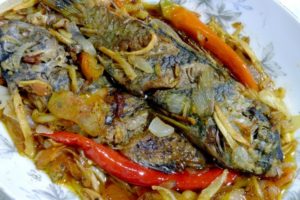
Kinamatisang Tinabal
MY TOPIC today is buwad, dried or preserved fish.
Since Holy Weekis approaching, let us stock up on this good old reliable food.
Buwad is the generic term for dried seafood.
It’s one favorite food among Filipinos, as well as a popular pasalubong for visitors of Cebu. Buwad production is a multi-million enterprise in Bantayan Island and neighboring islets like Doong. Here lies an endless stretch of fish drying under the sun, as well as locals cleaning and gutting fishes for drying.
The product is shipped all over Cebu and the Visayas.
I like going to Tabo-an market for my supply of buwad. The variety of buwad in Tabo-an will really fascinate you.
There’s the much sought-after Danggit, and Pinikas na Anduhaw or Anduhaw sliced in half for quicker drying.
There’s Bolinao or Turnos, also called Lansang (nails), which shares equal space with dried shrimps called Kalkag.
One can also buy a kind of big fat dried fish that is perfect for making Bacalao ala Viscaina.
How about Buwad nga Nukos (squid), which many of us can not get enough of.
My personal favorite are the small ones which cook quickly.
In Bantayan Island, they have semi-dried, lightly-salted Danggit (or other fish) called Labtingaw. It’s not as dry as buwad, and when fried it will actually have the taste of fresh fish. Labtingaw should be frozen to retain its freshness.
There is another buwad that is not often seen nowadays.
In my childhood I knew of dried sardines that was called Lawlaw.
These were sold in wooden boxes and the sardines were packed in a lot of salt.
My Lola Lilang used to fry them in pork lard and served with fried saba bananas. I swear, the Lawlaw was so salty, one piece could feed a whole family!
But if you go inside the Tabo-an market, pass the dried fish section, turn left when you see the fruits, continue walking until you reach the end section of the wet market where fresh fish are sold.
There you can see tubs of Ginamos, fermented small fishes and shrimps.
Beside these would be jars or open tubs of Tinabal.
What is Tinabal? If buwad is fish that has been dried under the sun, and Ginamos is fermented small fishes, Tinabal means whole
fish that is preserved by putting it in a covered container with lots of salt.
The fish of choice is usually Molmol or parrot fish.
The juice of the fish drips and mixes with the salt and the meat will be permeated by the brine.
The Tinabal is first washed then drained before it is fried in pork lard. You may fry it in vegetable oil but the
aroma will not be as good.
Then it is added to sautéed ginger, garlic, onions and tomatoes— make that lots of tomatoes.
This dish is good with boiled camote or saba bananas. Most people want this with a plateful of corn grits.
A whole family can feed on two pieces of Tinabal and a big caldero of rice or corn grits!
